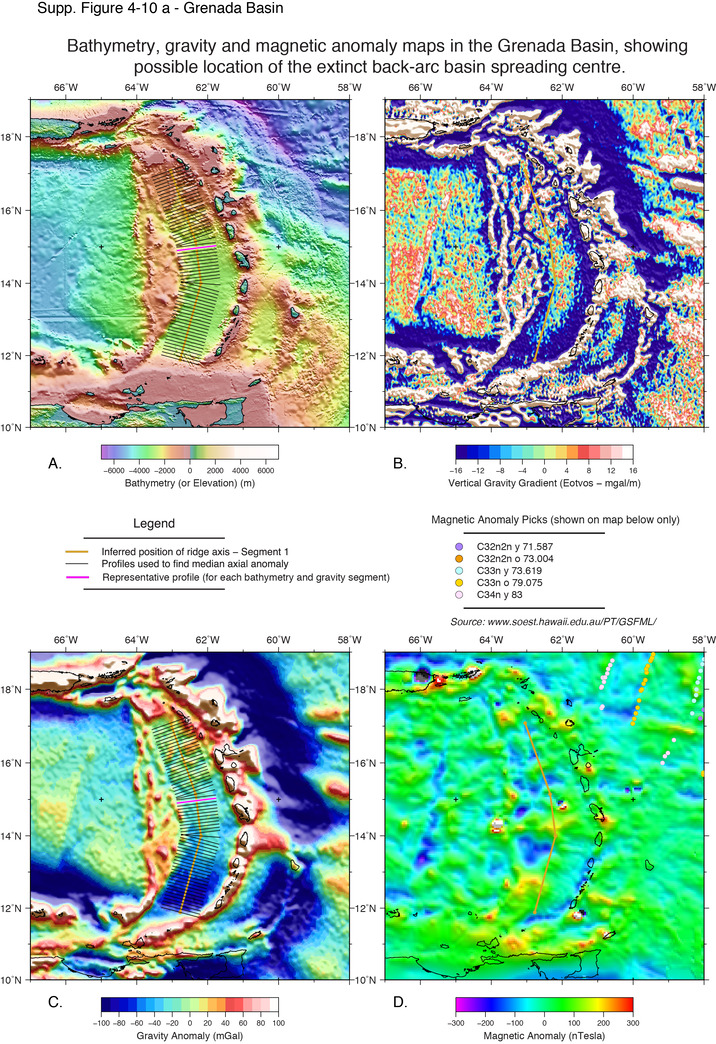| Ocean: | Marginal basin |
| Spreading center type: | Backarc basin spreading ridge |
| Time of cessation: | Poorly constrained (no chrons identified), ca. 35 Ma (Speed and Walker, 1991)) |
| Later deformation or volcanism: | Steep-angle normal faults cutting the eastern basement of the basin may be related to development of the Lesser Antilles Arc (Aitken et al. 2011). The north of the basin is also argued to have been “disrupted by the late Tertiary event responsible for the bifurcation of the Lesser Antilles” (Bird et al., 1993, p. 1277). Alternatively, Speed and Walker 1991 argue that there has been significant compression and uplift within the southern Grenada Basin. |
The Grenada Basin is located between the Aves Ridge to the west, which is an extinct Cretaceous-to-Paleocene arc, and the Lesser Antilles Arc to the east, a Paleocene-to-recent day island arc (Aitken et al., 2011). Seismic profiles oriented perpendicular to the inferred direction of spreading (RC 1904-15, Aitken et al., 2011, figure 6 top), do not show any significant basement feature that would suggest a ridge axial structure. The basin is referred to by Aitken et al. (2011) as a forearc basin, which necessitates its formation to the east of the suspected contemporaenous volcanic arc, that would probably have been the Aves Ridge.
Bird et al. (1993) interpreted magnetic anomaly trends in the basin, and this analysis demonstrated that spreading within the basin was very complex, making interpretation of the direction of opening difficult. Bird et al. (1993) proposed that the basin opened in a north-south direction from the observed east-west trend of magnetic anomalies.
Escalona and Mann (2011) argue that repeated eastward migration of the Caribbean plate-boundary caused subduction zone roll-back and that the backarc basin formed-crust was accreted to the Caribbean Plate, along with relict arcs, as newer arcs and backarcs develop to their east.
We were unable to identify any prospective features that might reflect the former axis of spreading within the Grenada Basin and therefore this center was not included in our statistical analysis.
Aitken, T., Mann, P., Escalona, A. and Christeson, G. L., 2011, Evolution of the Grenada and Tobago basins and implications for arc migration, Marine and Petroleum Geology, v. 28, no. 1, p. 235–258.
Bird, D. E., Hall, S. A., Casey, J.F. and Millegan, P.S., 1993, Interpretation of magnetic anomalies over the Grenada Basin, Tectonics, v. 12, no. 5, p. 1267-1279.
Escalona, A. and Mann, P., 2011, Tectonics, basin subsidence mechanisms, and paleogeography of the Caribbean-South American plate boundary zone. Marine and Petroleum Geology, v. 28, no. 1, p. 8–39.
Speed, R. C. and Walker, J. A., 1991, Oceanic crust of the Grenada Basin in the southern Lesser Antilles arc platform, Journal of Geophysical Research: Solid Earth, v. 96, no. B3, p. 3835-3851.


